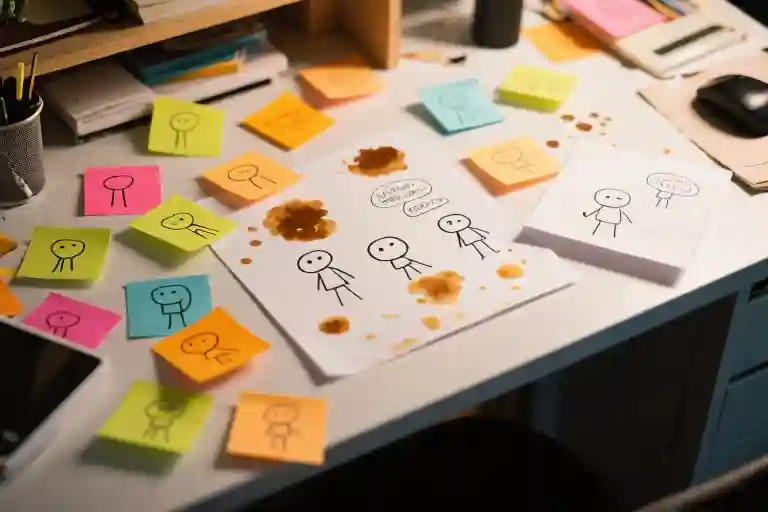The phone is already in my hand before I realize what’s happening. It’s that lull between meetings, the 12 minutes before the next Zoom call starts, and my fingers have automatically swiped open Instagram. No conscious decision was made—just the familiar itch of empty time that demands to be filled. Across the office, three colleagues are doing the same: one scrolling TikTok, another queuing up a podcast, a third checking LinkedIn notifications for the fifth time this hour. We’ve become experts at avoiding even sixty seconds of unoccupied mental space.
This reflexive reach for digital stimulation reveals something uncomfortable: we’ve developed a cultural allergy to boredom. That slight discomfort when waiting in line without checking emails, the twinge of anxiety when sitting through a commercial break without grabbing our phones—these reactions suggest we’ve pathologized what psychologists now recognize as a crucial cognitive resource. Recent neuroscience research reveals those blank moments we instinctively avoid might be our brain’s most generous gift to creative thinking.
Consider the irony: in our quest to optimize every waking moment through productivity apps and educational podcasts, we might be starving our minds of the very nutrient that fuels breakthrough ideas. The default mode network—often called our brain’s ‘idle setting’—becomes most active during precisely those unfocused moments we work so hard to eliminate. Like a library that can only reorganize its shelves after closing time, our minds need periods of apparent inactivity to make unexpected connections.
Yet here we are, treating mental white space like an enemy to be conquered. The average office worker now checks their phone 150 times daily, with 70% of these checks lasting less than two minutes—a clear pattern of using micro-distractions to ward off potential boredom. We’ve confused constant stimulation with productivity, mistaking the absence of external input for wasted time. What if the secret to better ideas isn’t filling every gap, but learning to comfortably inhabit them?
This cultural shift didn’t happen accidentally. Attention economy giants have spent billions designing interfaces that exploit our discomfort with stillness. Infinite scroll features, autoplay videos, and push notifications all serve as ‘boredom prophylactics’—preemptive strikes against any moment of mental quiet that might allow us to notice we’re not actually enjoying this compulsive consumption. The result? A society where, according to University of Virginia research, 67% of men and 25% of women would rather self-administer electric shocks than sit alone with their thoughts for 15 minutes.
But resistance is growing. Forward-thinking companies like Basecamp now build ‘boredom breaks’ into employee schedules, while schools in Scandinavia experiment with ‘unstructured contemplation time.’ Even tech insiders practice ‘digital sabbaths,’ recognizing that the most valuable ideas often emerge not during focused work, but in the shower, on walks, or while staring out a train window. Perhaps it’s time we reconsider our reflexive reach for devices—not as moral failure, but as an opportunity to reclaim one of cognition’s most underrated tools.
The Modern Panic of Empty Moments
You know that automatic reach for your phone when the elevator doors close? The instant urge to queue up a podcast while chopping vegetables? That reflexive twitch to fill every interstitial moment of your day with some form of digital stimulation? We’ve turned idle time into an existential threat, treating boredom like a malfunction light on life’s dashboard that demands immediate attention.
Our collective resistance to empty space manifests in increasingly creative ways. Morning commutes become mobile theater sessions with Netflix downloads. Gym sessions transform into university lectures via AirPods. Even shower stalls now double as podcast studios with waterproof Bluetooth speakers. According to Statista’s 2023 digital behavior report, the average person consumes 47% more media during ‘transitional moments’ than they did five years ago – we’re not just filling time, we’re stockpiling distractions like doomsday preppers.
Beneath this behavioral epidemic lies a tangle of psychological wiring. The silence we avoid isn’t really about silence at all – it’s about confronting the uncomfortable intimacy of our own unfiltered thoughts. Neurologists call this ‘cognitive dissonance avoidance,’ where the brain prefers external noise over internal uncertainty. Social psychologists point to our performative culture that equates busyness with worthiness – if you’re not consuming content, you’re not keeping up. And then there’s the subtle terror that in these empty moments, we might actually have to meet ourselves without the curated filters of productivity or entertainment.
What’s fascinating isn’t just that we do this, but how completely we’ve pathologized the alternative. Try sitting in a waiting room without reaching for your phone and notice the strange looks you receive – you might as well be licking the wallpaper. We’ve created a cultural norm where allowing mental white space feels almost transgressive, like skipping a vaccine or refusing to wear shoes in public. The unspoken rule is clear: empty time equals wasted time, and wasted time equals personal failure.
Yet this compulsive time-filling creates its own peculiar exhaustion. There’s a certain cognitive claustrophobia that sets in when every mental corridor is perpetually occupied. Like a houseguest who never leaves, our constant stream of media consumption leaves no room for the mind to stretch, rearrange furniture, or simply breathe. The irony is that in our quest to never waste a moment, we may be wasting something far more precious – the fertile void where creativity takes root.
This cultural resistance to boredom isn’t just personal habit – it’s big business. Social platforms engineer their algorithms to exploit what psychologist John Eastwood calls ‘the itch we can’t stop scratching.’ Attention economy architects deliberately target our biological aversion to uncertainty, turning what was once ordinary downtime into monetizable engagement opportunities. Every autoplay video, every infinite scroll feature, every ‘you might also like’ recommendation represents another brick in the wall between us and unstructured thought.
But here’s the quiet rebellion no one talks about: in that moment when you resist the urge to fill the silence, when you allow yourself to simply exist without input or agenda, you’re not being unproductive – you’re conducting radical brain maintenance. Like a computer running essential background updates, the mind uses these apparently empty moments to make connections it would otherwise miss. The science behind this phenomenon (which we’ll explore next) suggests we’ve been misunderstanding boredom all along – it’s not the enemy of productivity, but its secret collaborator.
The Science of Boredom: Your Brain’s Hidden Creative Workshop
That restless urge to check your phone during elevator rides or queue waits isn’t just habit—it’s a biological rebellion against what neuroscientists call “unstructured mental time.” The 2014 University of Central Lancashire study revealed something counterintuitive: participants who first endured the tedious task of copying phonebook entries later generated 27% more creative solutions than peers who watched stimulating videos. This isn’t academic trivia; it’s evidence that boredom functions like cognitive strength training.
Your brain’s default mode network (DMN) activates during these unfocused moments, behaving like a nocturnal cleaning crew in a bustling office. While conscious attention rests, distant neural regions begin conversing—the prefrontal cortex shares coffee with the hippocampus, the temporal lobe exchanges memos with the parietal cortex. These clandestine meetings birth unexpected connections, explaining why shower thoughts often solve workday problems. Functional MRI scans show DMN activity correlates with insight breakthroughs, not during focused work but in its aftermath.
Consider how libraries operate—daytime visitors access pre-shelved materials efficiently, but the real reorganization happens after closing when librarians reshelve, cross-reference, and discover overlooked relationships between disparate topics. Your mind works similarly. That afternoon zoning out during a tedious commute? That’s when your neural librarians are creating new Dewey Decimal systems for your experiences.
The creativity boost follows a U-curve: moderate boredom enhances divergent thinking more than either constant stimulation or extreme monotony. It’s the mental equivalent of a musician tuning an instrument—too loose creates dissonance, too tight risks snapping, but balanced tension produces harmony. This explains why historical innovators like Darwin structured their days with mandatory wandering time and why modern tech CEOs protect “blank space” in calendars.
Three neurological mechanisms make boredom your silent creative partner:
- Pattern interruption breaks cognitive ruts, allowing novel approaches to surface
- Reduced cognitive load frees working memory for subconscious processing
- Self-generated thought activates autobiographical planning and scenario simulation
Next time you instinctively reach for your phone to escape a dull moment, pause. That discomfort is your brain shifting gears from consumption to creation mode. The blank spaces you’ve been avoiding might contain the very insights you’ve been working toward.
What Boredom Taught Me: A Practitioner’s Diary
The alarm goes off at 7:03 AM, that strange prime number time I set to trick myself into thinking I’ve outsmarted routine. My fingers hover over the phone – three unread emails already blinking, a podcast queue begging to fill my shower time. But today, I leave it face down on the nightstand. The tiles feel colder than usual underfoot, the water louder without my usual true crime narration. I watch the steam curl toward the ceiling, tracing shapes that dissolve before I can name them. By 7:42, standing drip-dry in the morning quiet, the solution to yesterday’s design problem arrives unannounced. Not in a flash, but like a cat brushing against my ankles – there when I stopped looking for it.
This became my Tuesday ritual after reading about Einstein’s violin breaks. The man who redefined relativity would stop mid-equation to play Mozart, letting his fingers find what his conscious mind couldn’t. Neuroscientists now call this the ‘default mode network’ – the brain’s background processing that connects distant ideas when we’re not forcibly wiring them together. I think of it as mental composting; you have to let thoughts decompose before they can nourish new growth.
Take last month’s branding project. After three days of forcing concepts (and accumulating seventeen browser tabs of ‘inspiration’), I took a page from Haruki Murakami’s running habit. Not the marathon part – just the rhythmic monotony of left-right-left. Somewhere between mile two and three, with no podcast in my ears and no particular thoughts in my head, the client’s grandmother’s ceramic collection suddenly made sense as their visual motif. The kind of connection that feels obvious in hindsight but never appears under the glare of direct focus.
What surprised me most wasn’t these occasional breakthroughs, but the texture of ordinary moments when I stopped treating them as empty calories to be filled with content. The way morning coffee tastes different when you’re not simultaneously scanning headlines. How subway ads reveal their hidden patterns when you’re not scrolling past them. There’s an art to this kind of attention that our productivity culture has untaught us – the skill of receiving rather than capturing.
JK Rowling famously conceived Harry Potter during a delayed train journey with nothing but her thoughts and a napkin to scribble on. But you don’t need Platform 9¾ to experiment with creative boredom. Try:
- Washing dishes without a podcast (your hands know the motions anyway)
- Taking the long way to the coffee machine, noticing which coworkers have family photos vs. minimalist desks
- Staring out the window until your eyes unfocus, letting peripheral vision gather what center focus misses
Here’s the uncomfortable truth: most of these moments won’t yield brilliant ideas. That’s why we avoid them. But the few that do – the shower epiphanies, the sidewalk insights – remind us that creativity isn’t always something we do. Sometimes it’s what happens when we stop doing everything else.
When was the last time boredom surprised you? Not the soul-crushing kind of pointless meetings or traffic jams, but the fertile emptiness you chose to sit with? Mine happened yesterday, watching condensation slide down my iced tea glass while the restaurant chatter blurred around me. The server’s tattoo – a half-hidden constellation – became the missing element for a client’s astronomy app design. It would’ve been easier to pull out my phone.
The Boredom Action Manual: From Resistance to Embrace
The moment your hands are free, your fingers twitch toward the phone. It’s an automatic response, like blinking when dust approaches your eyes. We’ve conditioned ourselves to treat empty moments as emergencies, rushing to fill them with podcasts, social media, or background TV noise. But what if these pockets of nothingness aren’t voids to be filled, but gardens waiting to be planted?
Starting Small: The 5-Minute Sensory Reset
Begin with what I call ‘pure sensory time’ – short intervals where you simply notice. Not analyze, not document, just receive. Tomorrow morning when your coffee steams, don’t reach for your phone. Watch how the tendrils curl and dissolve. Notice the weight of the mug, the way heat transfers through ceramic. These five minutes of deliberate boredom create mental white space where unexpected connections form. A graphic designer client reported solving a layout problem during such a coffee moment, her mind free to wander without the usual digital interruptions.
The Analog Hour Challenge
Once comfortable with micro-moments, try a weekly ‘Analog Hour’ – sixty minutes using only physical tools. Carry a pocket notebook instead of your phone’s memo app. Read paper books without Googling unfamiliar terms. The constraint forces your brain to work differently. Novelist Jonathan Franzen famously writes on a computer with disabled internet access, creating intentional limitations that paradoxically expand creativity. Your analog hour might involve sketching with actual pencils or cooking without following online recipes. The key isn’t nostalgia for pre-digital life, but creating conditions where your mind can meander without hyperlinks.
Tech That Protects Your Boredom
Ironically, certain apps can safeguard your empty moments. Tools like Moment or Screen Time (built into iOS) allow scheduling ‘blank periods’ where specific apps lock. I set mine to disable podcasts during dog walks, transforming what was ‘learning time’ into ‘noticing time.’ The first week felt uncomfortably quiet; by month three, these walks became my most reliable idea generators. For Android users, Digital Wellbeing offers similar focus modes. Think of these not as restrictions, but as creativity incubators.
The Resistance You’ll Face
Expect internal pushback. Your brain, trained by instant gratification, will protest that staring out the train window is ‘wasted time.’ That’s when to recall the 2019 University of Arizona study showing people who endured boredom tasks subsequently demonstrated markedly improved problem-solving abilities. The discomfort is the growth point. When the itch to check your phone arises, pause and ask: ‘What might emerge if I don’t?’
Boredom’s Ripple Effects
These practices gradually rewire your relationship with empty space. A marketing director who adopted analog hours reported unexpected benefits: ‘I now have 3-4 truly original ideas weekly, compared to maybe one per month before.’ More than productivity gains, many report heightened presence – that elusive state we ironically chase through mindfulness apps while multitasking. The very stillness we avoid becomes the ground from which fresh perspectives grow.
What makes these methods work is their scaffolding – they provide just enough structure to make voluntary boredom feel safe and purposeful. You’re not abandoning responsibilities to stare at walls, but strategically creating mental breathing room. Like any new skill, initial attempts may feel awkward. That’s normal. The magic happens when what began as scheduled boredom becomes spontaneous curiosity, when the space between tasks transforms from something to endure into something to explore.
The Fine Line Between Productive Boredom and Harmful Procrastination
That moment when you catch yourself staring blankly at the coffee stain on your desk instead of working – is it creative incubation or just avoidance? The difference between healthy boredom and destructive procrastination often comes down to one crucial factor: intentionality.
The Charging vs. Crashing Spectrum
Productive boredom feels like stepping back to let your mental browser refresh tabs. There’s a subtle but distinct sensation of active waiting – your shoulders might relax, your breathing slows, yet some part of your mind remains alert like a cat watching a mouse hole. This is your brain’s default mode network doing its best work, making connections between seemingly unrelated ideas.
Compare this to procrastination’s telltale physical symptoms: the clenched jaw when you’re scrolling through social media instead of writing that report, the stomach drop when you realize another hour evaporated without progress. True creative boredom never leaves you with that acidic aftertaste of self-reproach.
The 15/5 Rule for Balanced Boredom
Here’s a practical framework I’ve tested:
- Set a timer for 15 minutes of deliberate boredom – no inputs, just letting your mind wander while doing simple tasks like folding laundry or watering plants.
- When the alarm sounds, spend 5 minutes with a sticky note to either:
- Capture any insights that emerged
- Confirm you’re still on track with priorities
This creates a safety net against aimless drifting. The brief check-in maintains just enough structure to prevent free time from mutating into avoidance behavior. I’ve found this works particularly well during afternoon slumps when forcing productivity often backfires.
Recognizing the Danger Signs
Not all empty time is created equal. Watch for these red flags that your boredom has crossed into unproductive territory:
- You start rationalizing (“I work better under pressure anyway”)
- Physical tension builds rather than dissipates
- The activity you’re using to fill time requires zero mental engagement
- You find yourself repeatedly checking the clock with growing dread
Creative boredom should feel like stretching stiff muscles, not like hiding from responsibilities. The sweet spot? That gentle mental hum when you’re not actively working on a problem, but somehow know your subconscious is.
The Permission Paradox
What surprised me most in experimenting with intentional boredom was realizing how much energy I’d been wasting on resisting it. Like holding your breath underwater only to surface gasping, we often exhaust ourselves fighting something that might actually sustain us. The modern workplace’s cult of constant productivity has convinced us that any unoccupied moment represents failure, when in truth, these may be the only moments when breakthrough ideas can surface.
There’s an art to distinguishing between the fertile pause and the paralyzing stall. Start by noticing – without judgment – where your particular balance point lies. Some days you’ll tip too far into avoidance; others you’ll short-circuit potentially valuable incubation time. That’s okay. The awareness itself becomes the compass.
The Quiet Revolution: Reclaiming Boredom in a Noisy World
The phone buzzes. A podcast plays. The TV murmurs in the background. We’ve become so adept at filling every silent crevice of our days that we’ve forgotten what true stillness feels like. That moment when you’re waiting in line or sitting on a train and your fingers automatically reach for your phone – that’s the reflex we’re here to examine. Not to judge, but to question: what might we be losing in our compulsive avoidance of empty moments?
Neuroscientists have begun calling boredom “the gateway to mindfulness” – an unexpected ally in our quest for creativity and mental clarity. The same blank spaces we rush to fill might actually be our brain’s most fertile ground. Think of it as mental fallow land: what appears unproductive to the untrained eye is actually preparing the soil for richer harvests.
The Science of Spacious Thinking
When researchers at the University of Central Lancashire asked participants to complete a creative thinking test, they made a curious discovery. The group that first endured a boring task (copying numbers from a phone book) outperformed others by 27% in generating novel ideas. This isn’t an anomaly – it’s biology. Our brains have a remarkable “default mode network” that activates when we’re not focused on specific tasks. Like a background app quietly organizing files while you’re away from your desk, this network makes unexpected connections, solves lingering problems, and incubates new ideas.
The Practice of Productive Pauses
Implementing strategic boredom doesn’t require dramatic life changes. Start small:
- Turn your morning shower into a “no podcast zone” – let the water and your thoughts flow uninterrupted
- Try the “5-5-5” commute rule: first 5 minutes device-free, observing your surroundings with fresh eyes
- Create a “boredom bookmark” – when you instinctively reach for your phone, pause for three breaths first
These micro-practices build what psychologists call “tolerance for undistracted being” – the ability to remain present with your own mind. You might notice, as I did, that solutions to stubborn problems often emerge not during focused work, but in these interstitial moments of mental wandering.
The Delicate Balance
Of course, not all empty time is created equal. There’s a crucial distinction between intentional boredom and chronic avoidance:
- Healthy boredom feels like stretching after sitting – a conscious release of mental tension
- Unproductive avoidance carries a subtle anxiety, a sense of time slipping through your fingers
The litmus test? After your boredom break, do you feel replenished or guilty? The former suggests you’ve given your mind needed space; the latter might indicate you’ve crossed into procrastination.
An Invitation to Do Less
Here’s your challenge: within the next 24 hours, identify three moments when you’d normally reach for stimulation – maybe while waiting for coffee to brew or before a meeting starts – and instead, simply be. Don’t meditate, don’t “practice mindfulness” with any agenda. Just exist in that space without filling it. Notice what arises.
That flutter of discomfort you feel? That’s the sound of your creativity waking up. The greatest ideas often come unannounced, slipping in through the cracks of our carefully constructed schedules. The question isn’t whether boredom has value – science has answered that. The real question is: are you brave enough to leave the door open for it?





